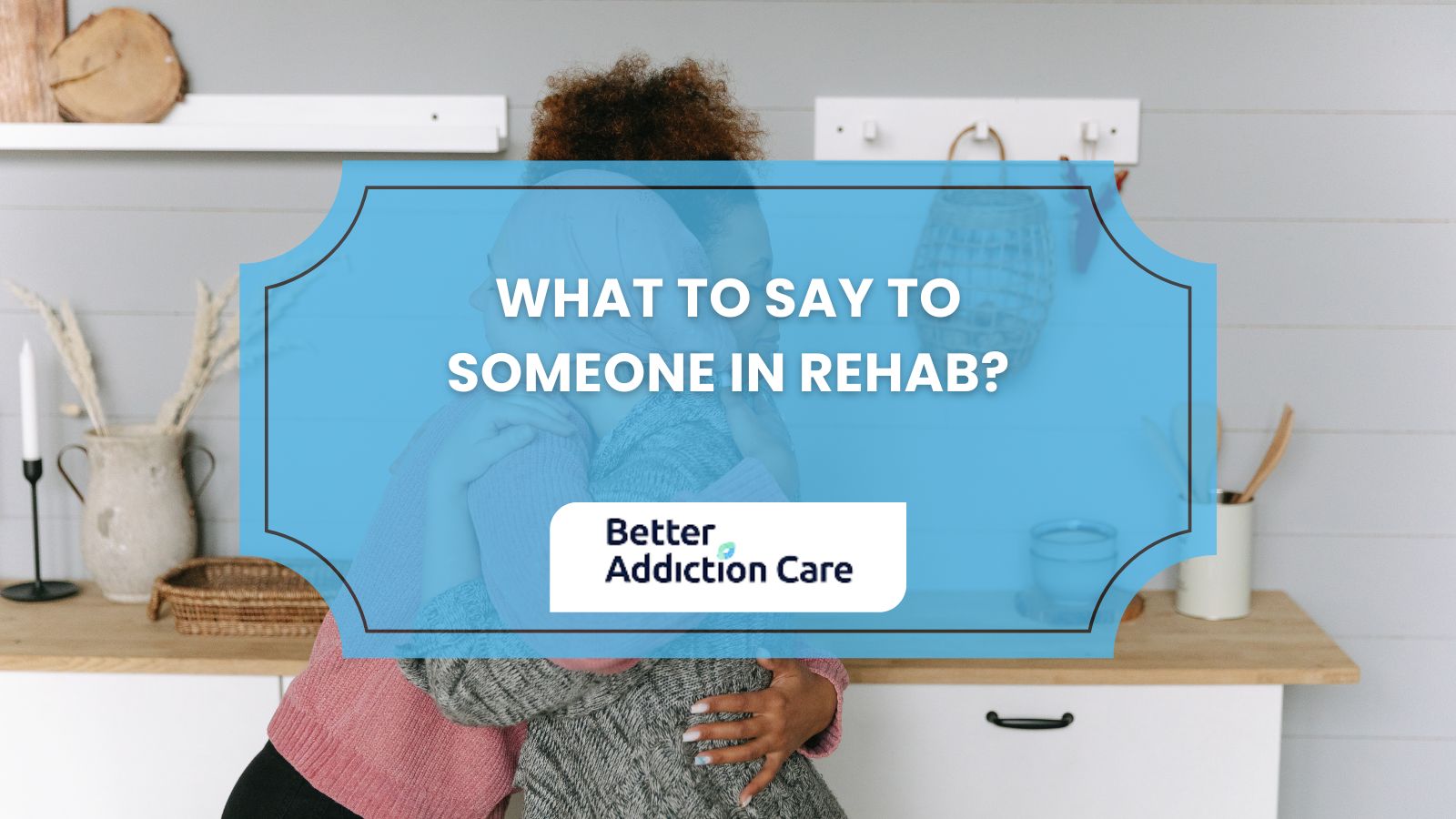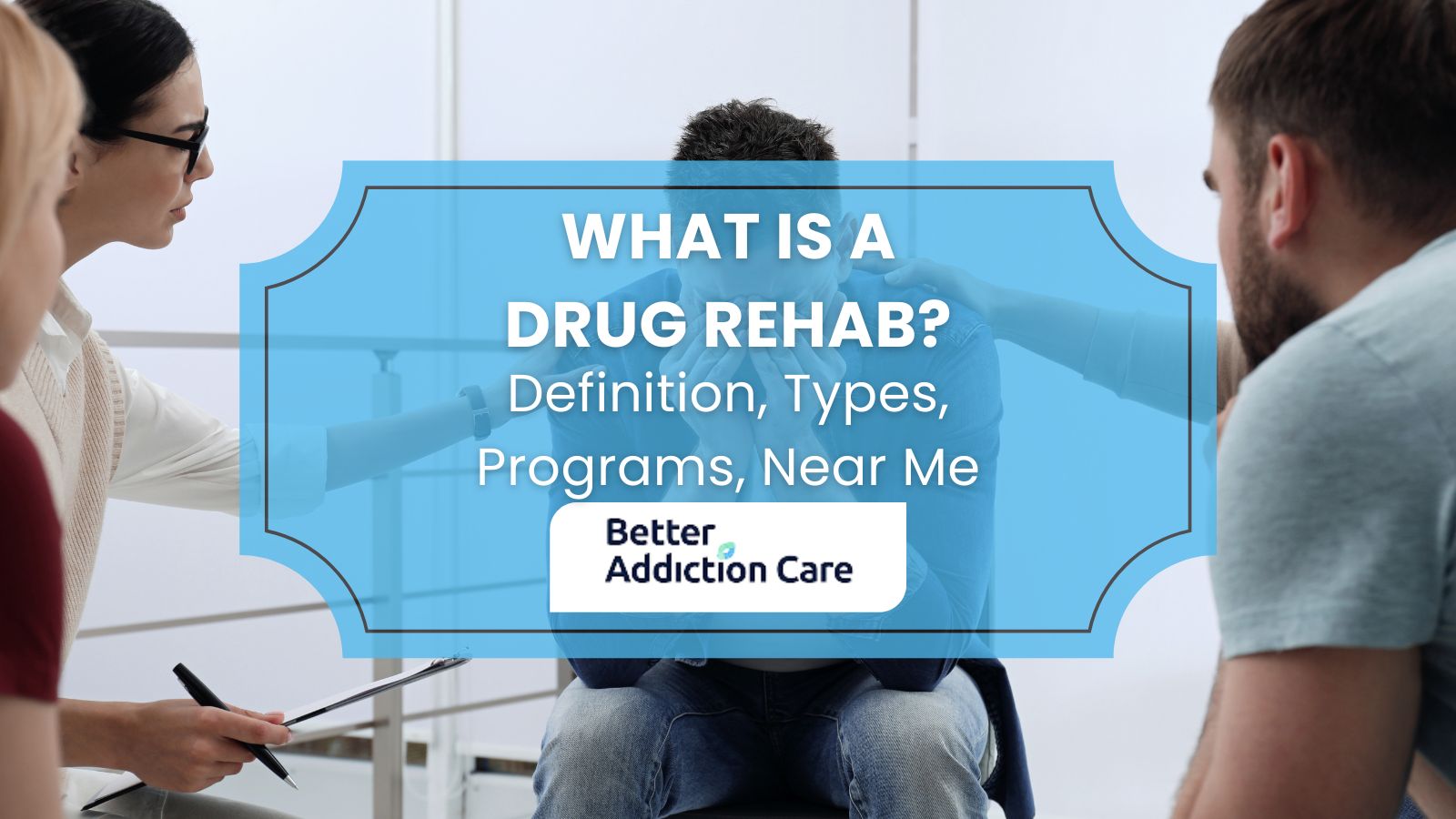Halfway House: Definition, Purpose, How it Works, Eligibility, Benefits
A halfway house is a structured, substance-free living environment designed to support individuals transitioning from treatment to independent, sober living. These residences serve as a bridge between intensive addiction treatment and full reintegration into society, offering stability, accountability, and continued recovery support.
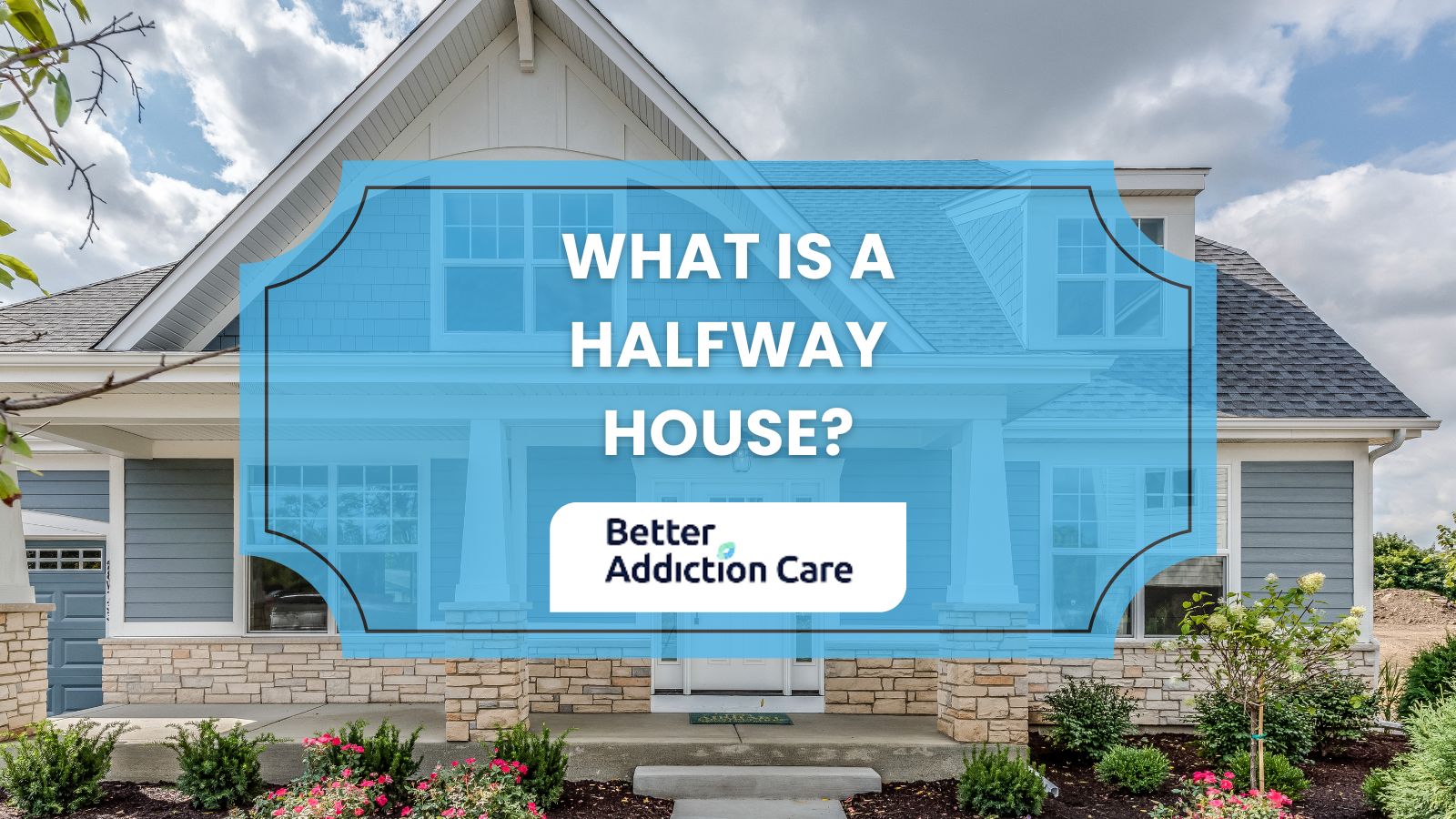
A halfway house is a structured, substance-free living environment designed to support individuals transitioning from treatment to independent, sober living. These residences serve as a bridge between intensive addiction treatment and full reintegration into society, offering stability, accountability, and continued recovery support.
Individuals who transition through halfway houses experience higher abstinence rates and reduced relapse risks compared to those who return directly to their previous environments, as noted by Smart (2009) in the study "Outcome Studies of Therapeutic Community and Halfway House Treatment for Addicts."
Halfway houses function as peer-supported communities, requiring residents to follow house rules, maintain sobriety, participate in recovery programs, and contribute to daily responsibilities. They offer structured schedules while allowing individuals to regain independence, seek employment, and rebuild personal relationships.
Eligibility for halfway house residency includes individuals completing inpatient rehab, those in early recovery, people under court-mandated supervision, and individuals seeking additional support before living independently. These homes provide a stable environment for those committed to long-term sobriety.
The benefits of halfway houses include reinforced accountability, peer encouragement, structured recovery support, and a gradual transition into independent living. By fostering personal responsibility and providing important recovery tools, halfway houses play an important role in sustained addiction recovery and successful reintegration into daily life.
What is a Halfway House?
A halfway house, also known as transitional housing, is a community-based residential facility that provides temporary housing and support services to individuals transitioning from incarceration or substance use treatment back into society. According to the U.S. Department of Justice, Bureau of Justice Statistics (BJS) in "Residential Substance Abuse Treatment for State Prisoners Program" (2020), there are 3,000 halfway houses in the U.S., serving tens of thousands annually. Residents experience a 10-20% lower recidivism rate, with 65% reporting improved sobriety outcomes.
Halfway houses serve as a bridge between intensive rehabilitation programs and independent living. They provide residents with a supportive, substance-free setting where they continue their recovery journey, develop important life skills, and establish a stable foundation before fully reintegrating into the community.
The primary purpose of a halfway house is to promote accountability, sobriety, and personal growth among residents. By offering structured living conditions, these facilities create an environment that encourages long-term recovery and successful reintegration into society.
What is the Purpose of a Halfway House?
The purpose of a halfway house is to promote independence, sobriety, and stability among individuals recovering from substance use disorders or transitioning from incarceration. They provide residents with a supportive, substance-free setting where they continue their recovery journey, develop important life skills, and establish a stable foundation before fully reintegrating into the community. According to the U.S. Department of Justice, Bureau of Justice Statistics (BJS) in "Residential Substance Abuse Treatment for State Prisoners Program" (2020), individuals in recovery who stay in halfway houses for at least six months have a significantly lower risk of relapse than those who do not utilize transitional housing. Additionally, 70% of residents secure employment during their stay, which helps reduce relapse and reoffending. The cost of staying in a halfway house ranges from $450 to $1,200 per month, making it a cost-effective alternative to incarceration or inpatient treatment.
How Do Halfway Houses Help Individuals Transition From Addiction Treatment?
Halfway houses help individuals transition from addiction treatment by offering structured schedules, support groups, and life skills training that create a stable environment for long-term sobriety. These residences establish daily routines, recovery-focused activities, and peer accountability, reinforcing healthy habits and personal discipline.
Structured schedules ensure that residents engage in daily responsibilities, counseling sessions, and employment or educational pursuits, helping them regain independence in a supportive environment. Support groups provide a network of peers in recovery, fostering mutual encouragement and shared accountability. Life skills training equips residents with important skills such as financial management, job readiness, and healthy communication, promoting long-term success in independent living.
How Do Halfway Houses Work?
Halfway houses operate as structured transitional residences designed to help individuals reintegrate into society while maintaining sobriety and stability. These homes are privately owned, nonprofit-operated, or government-funded facilities. Funding sources include state grants, private donations, and resident fees. Some halfway houses are affiliated with addiction recovery organizations or mental health programs, while others focus on individuals transitioning from incarceration.
Staff members, including house managers, caseworkers, and recovery specialists, oversee daily operations, enforce rules, and provide support. Residents follow structured daily schedules that include curfews, mandatory therapy sessions, job search requirements, and house meetings. This structured environment helps individuals build independence while maintaining accountability.
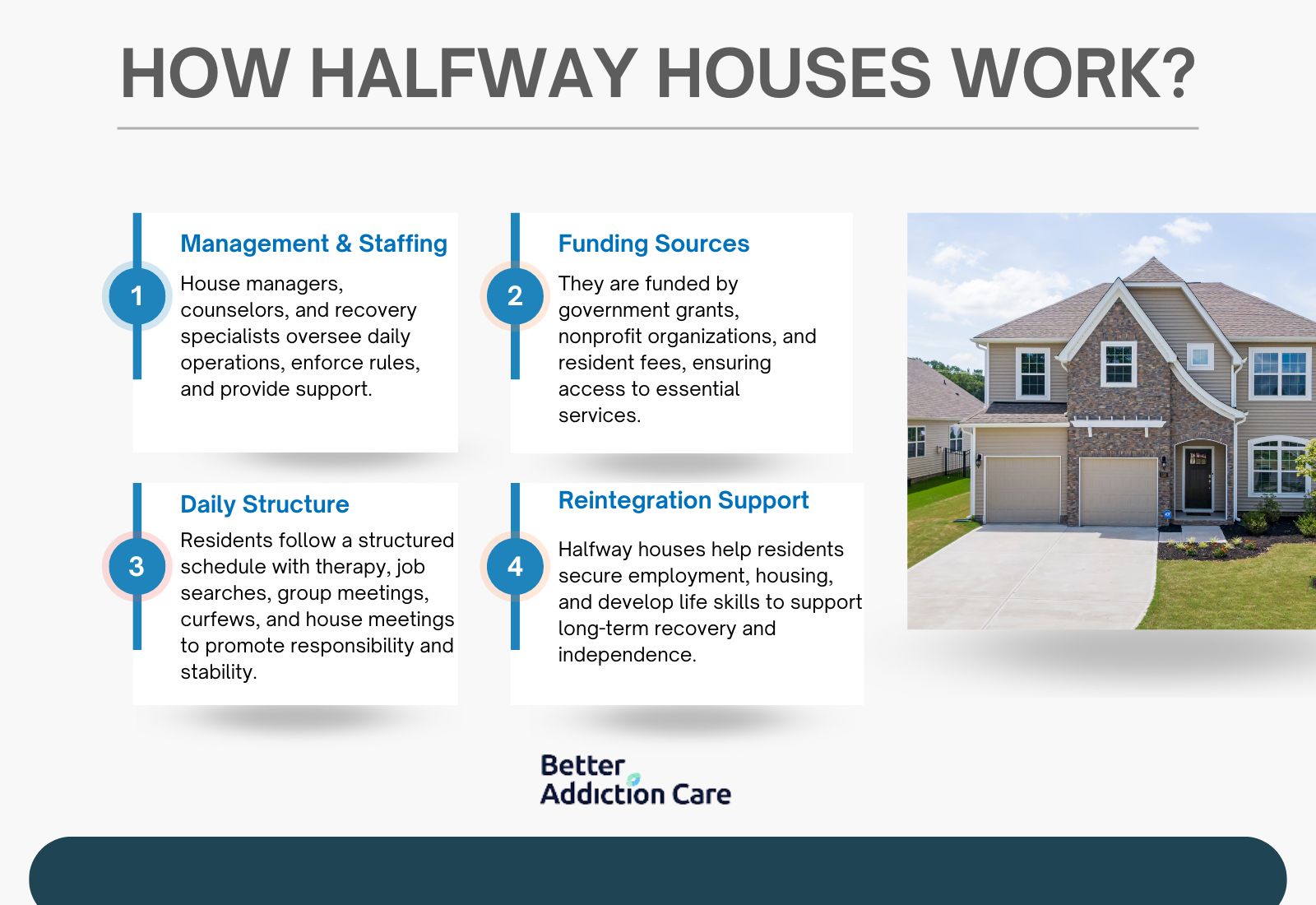
Key Aspects of How Halfway Houses Operate:
-
Management & Staffing: Halfway houses are overseen by house managers, counselors, and recovery specialists who monitor residents, enforce house rules, and provide support. These staff members ensure that residents follow curfews, attend therapy sessions, and participate in recovery programs. Their role is important in maintaining structure, accountability, and a safe environment for individuals transitioning to independent living.
-
Funding Sources: Halfway houses receive financial support through government grants, nonprofit organizations, and resident fees. Some facilities are entirely state-funded, while others rely on private donations or require residents to contribute toward housing costs. This funding ensures that the homes provide important services, including counseling, job placement assistance, and addiction recovery support.
-
Daily Structure: Residents in halfway houses follow a structured schedule that includes therapy sessions, job search requirements, and group meetings. Many facilities enforce curfews and require participation in house meetings to encourage responsibility and stability. These structured routines help residents establish independence while maintaining a focus on their recovery.
-
Reintegration Support: Halfway houses assist residents in securing employment, finding stable housing, and developing life skills necessary for independent living. Many programs offer career counseling, vocational training, and financial planning resources to help individuals transition successfully. This support system reduces the risk of relapse and prepares residents for long-term stability in society.
What Are Typical Rules and Regulations of Halfway Houses?
The typical rules and regulations of halfway houses establish guidelines to promote sobriety, accountability, and reintegration into society. These regulations help maintain a structured, substance-free environment where residents focus on their recovery and personal growth.
Common Rules in Halfway Houses:
-
Sobriety: Residents must remain drug- and alcohol-free, with regular testing to ensure compliance.
-
Curfew: Strict curfews are enforced to ensure structure and responsibility in daily routines.
-
Employment or Education Requirements: Residents must actively seek employment, attend school, or participate in vocational training.
-
House Meetings: Attendance at scheduled house meetings is mandatory to encourage peer support and accountability.
-
Chores and Responsibilities: Residents share household duties, such as cleaning and cooking, to maintain a cooperative living environment.
-
Mandatory Recovery Meetings: Participation in 12-step programs or therapy sessions is required to reinforce recovery efforts.
-
No Unauthorized Guests: Visitors must be pre-approved, and overnight stays are generally prohibited to maintain a safe environment.
-
Zero Tolerance for Violence or Criminal Activity: Any form of aggression or illegal activity results in immediate removal from the home.
Who is Eligible to Live in a Halfway House?
The people eligible to live in halfway houses are individuals who are transitioning from addiction treatment, mental health care, or incarceration and need a structured living environment before living independently. These residences serve people who are committed to addiction recovery, mental health stability, or social reintegration.
Eligibility criteria include sobriety, willingness to comply with house rules, and referrals from treatment programs or correctional facilities. Some halfway houses specialize in substance use recovery, while others focus on reentry from incarceration or mental health stabilization. Individuals who meet these criteria gain access to housing, counseling, job assistance, and peer support to help them successfully reintegrate into society. According to Vaslamatzis, Atsouyanni, and Arkidis in "The Efficacy of a Psychiatric Halfway House: A Study of Hospital Recidivism and Global Outcome Measure", individuals with longer stays in halfway houses had better post-residency outcomes, including higher employment rates and independent living success. Additionally, compliance with medication was linked to lower hospital recidivism rates, emphasizing the role of structured halfway house environments in promoting stability.
What Are the Benefits of Halfway Houses in Addiction Recovery?
The benefits of halfway houses in addiction recovery include structure, accountability, and relapse prevention, helping individuals build independence while maintaining sobriety. These homes provide a safe, substance-free environment where residents receive support and guidance as they transition to independent living.
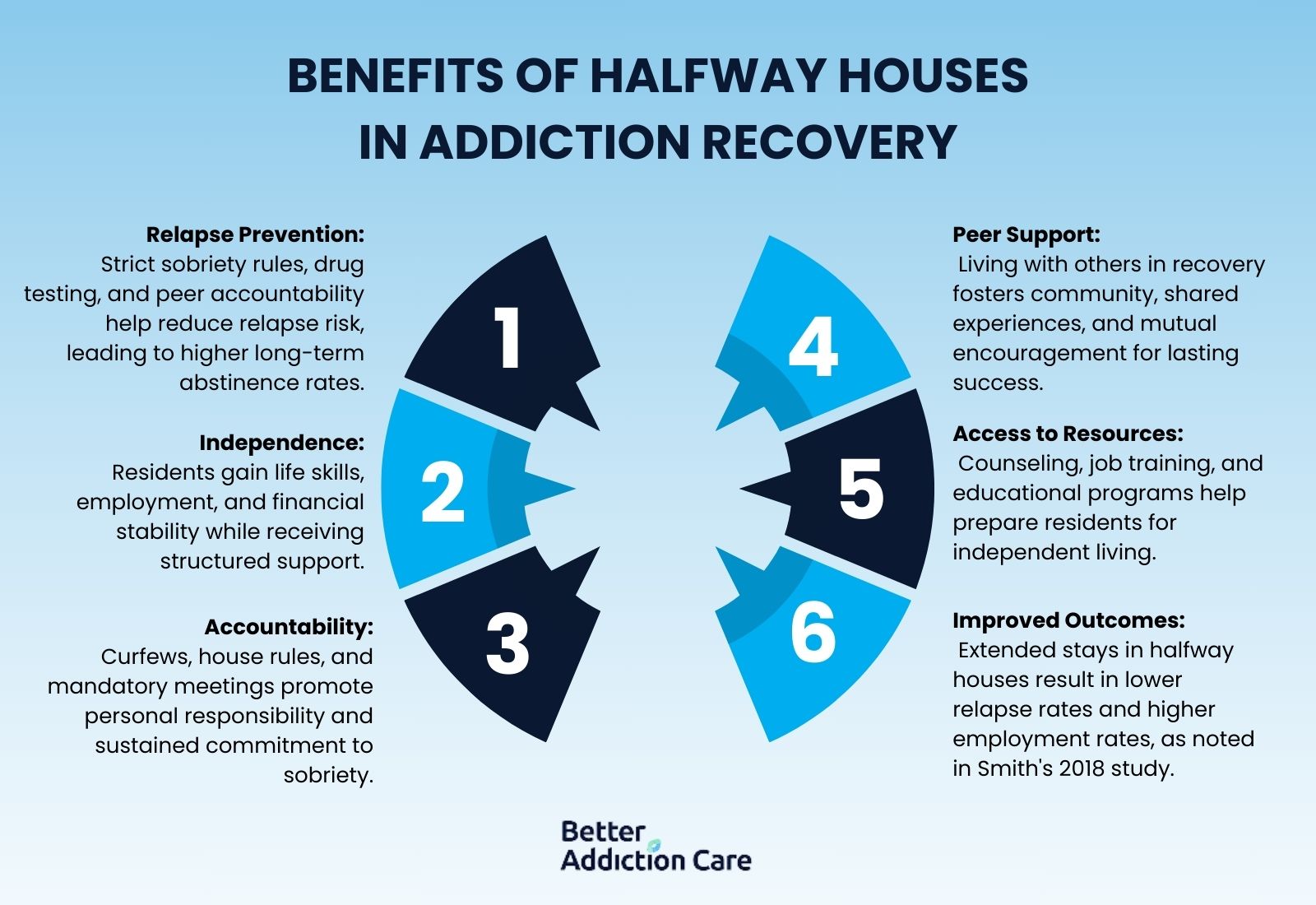
The benefits of halfway houses include:
-
Relapse Prevention: Halfway houses enforce strict sobriety rules, regular drug testing, and peer accountability, reducing the risk of relapse. Individuals who transition through structured recovery housing have higher long-term abstinence rates than those returning directly to independent living.
-
Independence: Residents develop life skills, secure employment, and build financial stability while still receiving structured support.
-
Accountability: House rules, curfews, and mandatory recovery meetings ensure personal responsibility and continued commitment to sobriety.
-
Peer Support: Living alongside others in recovery creates a sense of community, shared experiences, and mutual encouragement that reinforces long-term success.
-
Access to Resources: Many halfway houses offer counseling, job training, and educational programs to help residents prepare for independent living.
-
Improved Outcomes: According to Smith in "An Evaluation of the Effectiveness of a Halfway House Program for Parolees Released from the Correctional System" (2018), individuals who stay in a halfway house for at least six months have significantly lower relapse rates and higher employment rates compared to those who do not participate in the program. This study highlights the positive impact of extended stays in halfway houses on reducing relapse and improving long-term stability for individuals transitioning from the correctional system.
Can You Leave a Halfway House During the Day?
Yes, you can leave a halfway house during the day however it is only permitted under specific conditions outlined in house policies. Residents are allowed to leave for work, medical appointments, or approved activities, but must follow curfews, sign-in/sign-out procedures, and obtain staff permissions when necessary. According to Halfway House Rules/Regulations by United States Courts, residents must comply with all movement restrictions and supervision guidelines to ensure structure and accountability.
Can You Work While in a Halfway House?
Yes, you can work while in a halfway house. Working while in a halfway house is required or strongly encouraged to help residents build financial independence and stability. Employment supports long-term recovery by promoting responsibility, structure, and self-sufficiency. Many halfway houses require proof of active job searching or employment as part of their recovery plan.
Can You Have Family and Friends Visit in a Halfway House?
Yes, family and friends are allowed to visit halfway house residents, but visitation policies are in place to maintain a safe and structured environment. Visitors must follow set visiting hours, gain pre-approval, and comply with security measures to ensure the home remains a stable recovery setting. Overnight stays, bringing outside substances, or violating house rules result in denied visits to protect residents' sobriety. Visitation policies encourage healthy family connections while maintaining the focus on recovery.
How Do Halfway Houses Manage Security and Safety for Residents?
Halfway houses manage security and safety for residents through strict supervision, drug testing, and house rules that reinforce accountability. Staff members monitor residents, conduct regular substance screenings, and enforce curfews to maintain a substance-free environment. Security measures include visitor screenings, restricted entry policies, and emergency response protocols to protect residents from external risks. Peer accountability and structured living help create a supportive space where individuals focus on long-term recovery without outside distractions.
How Do Halfway Houses Support Mental Health During Addiction Recovery?
Halfway houses support mental health during addiction recovery by providing therapy, support groups, and structured routines that help individuals manage co-occurring disorders. Many facilities offer individual counseling, group therapy, and access to psychiatric care to address underlying mental health conditions that contribute to addiction. 17.5% of adults with a mental illness also have a substance use disorder, emphasizing the need for integrated treatment according to the Substance Abuse and Mental Health Services Administration. Support groups and structured peer environments promote accountability, emotional stability, and relapse prevention, helping individuals build resilience in recovery.
How Long Can You Stay in a Halfway House?
The length of stay in a halfway house ranges from three to twelve months, depending on individual progress, program requirements, and financial considerations. Some residents stay longer to reinforce sobriety, secure stable employment, and transition to independent living. Facilities assess progress through treatment participation, employment status, and adherence to house rules to determine readiness for the next step in recovery.
What Are the Key Differences Between Halfway Houses and Sober Living Homes?
The difference between halfway houses and sober living homes is the structure, rules, and purpose. Halfway houses are government-funded, time-limited, and include mandatory treatment or supervision for individuals transitioning from rehab or incarceration. Sober Living homes are privately operated, self-funded, and provide a more flexible, peer-driven environment for individuals seeking long-term recovery support without strict program timelines.
What Are the Common Challenges Faced by Halfway Houses in the U.S.?
The challenges faced by halfway houses in the U.S. include financial constraints, staffing shortages, societal stigma, and the difficulty of balancing safety with rehabilitation. Many facilities struggle to meet the growing demand for transitional housing while maintaining effective support systems.
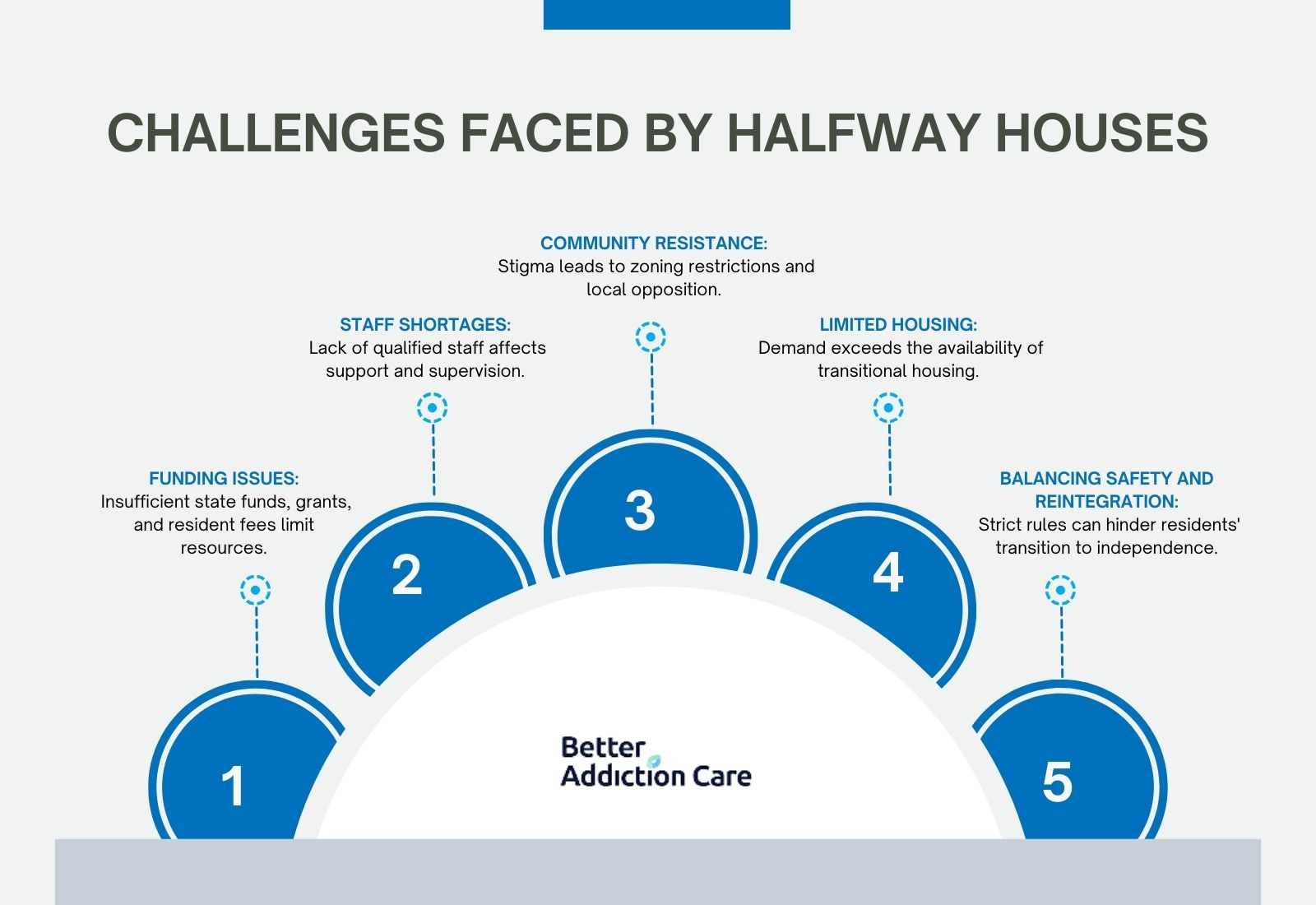
Some of the most pressing challenges are outlined below:
-
Funding Limitations: Many halfway houses depend on state funding, grants, and resident fees, which fail to cover operational costs, limiting resources and services.
-
Staffing Shortages: A lack of qualified staff affects supervision, counseling, and overall support for residents, reducing the effectiveness of rehabilitation programs.
-
Community Opposition: Public stigma around addiction and criminal rehabilitation leads to zoning restrictions and resistance from local communities, making it difficult to establish or expand facilities.
-
Limited Housing Availability: Demand for transitional housing exceeds supply, leaving many individuals without structured recovery support.
-
Balancing Safety and Reintegration: While strict rules are necessary for maintaining order, they must also allow residents to transition toward independent living without excessive restrictions.
How Much Does a Halfway House Cost?
The cost of halfway houses ranges from $500 to $2,500 per month, depending on location, amenities, and services provided. Government-funded halfway houses offer lower costs or free residency for eligible individuals, while private facilities charge higher fees due to additional services like counseling, job assistance, and medical care. The cost structure varies based on residence duration, house policies, and individual financial resources.
Use our drug rehab locator to find affordable halfway houses across California, Illinois, Texas, New York, Florida, Massachusetts, Oklahoma, Georgia, and Pennsylvania. Search by location to compare costs and services, from government-funded options offering free or low-cost residency to private facilities with comprehensive support programs, helping you find transitional housing that fits your budget and recovery needs.
Are Halfway Houses Co-ed?
No, most halfway houses are not co-ed and provide separate living spaces for men and women to maintain structure, safety, and focus on recovery. Some facilities offer co-ed housing with designated male and female sections, but most prioritize gender-specific environments to reduce distractions and reinforce accountability in recovery.
Do Halfway Houses Provide Food?
Yes, some halfway houses provide food, but policies vary by facility. Many government-funded and nonprofit halfway houses offer meals as part of the program, ensuring that residents have access to nutritious food while focusing on recovery. Others require residents to purchase and prepare their own meals, promoting independence and financial responsibility. According to the National Institute on Drug Abuse (NIDA), structured living environments that include proper nutrition plans and meal support contribute to lower relapse rates, improved cognitive function, and better overall physical and mental health for individuals in recovery. Access to balanced meals rich in essential nutrients has been linked to enhanced mood stability, reduced cravings, and improved decision-making skills, all of which are critical for maintaining long-term sobriety.
Do Halfway Houses Provide Medical or Therapy Services?
No, most halfway houses do not provide on-site medical or therapy services, but they require residents to attend outpatient treatment, therapy, or counseling as part of their recovery plan. Some transitional housing programs partner with clinics and outpatient providers to ensure residents receive medication management, therapy, or psychiatric care. Residents are responsible for arranging their medical and mental health services outside of the halfway house.
What Happens if Someone Relapses in a Halfway House?
When someone relapses in a halfway house, they face consequences based on house policies, which include immediate eviction, increased supervision, or referral to a higher level of care. Many halfway houses enforce zero-tolerance policies, requiring residents who relapse to leave immediately to maintain a sober environment. Some facilities offer a second chance with additional drug testing, recovery meetings, or stricter rules if the relapse is reported voluntarily. The National Institute on Drug Abuse (NIDA) states that relapse is common in recovery, with rates ranging from 40% to 60%, emphasizing the importance of structured support to prevent future substance use.
Do Halfway Houses Drug Test Residents?
Yes, halfway houses drug test residents regularly to ensure accountability and sobriety. Testing frequency varies but includes random, scheduled, or suspicion-based screenings. Drug tests help maintain a substance-free environment and reinforce personal responsibility. Failure to pass a drug test results in consequences such as warnings, probation, or removal from the program.
Are Halfway Houses Only for People Recovering from Addiction?
No, halfway houses are not only for people recovering from addiction. Many facilities serve individuals transitioning from incarceration, homelessness, or mental health treatment who need a structured, supportive living environment. While addiction recovery is a primary focus, some halfway houses support mental health stabilization, employment reintegration, and independent living skills for various populations.
Related Articles
Treatment Centers in Utah





